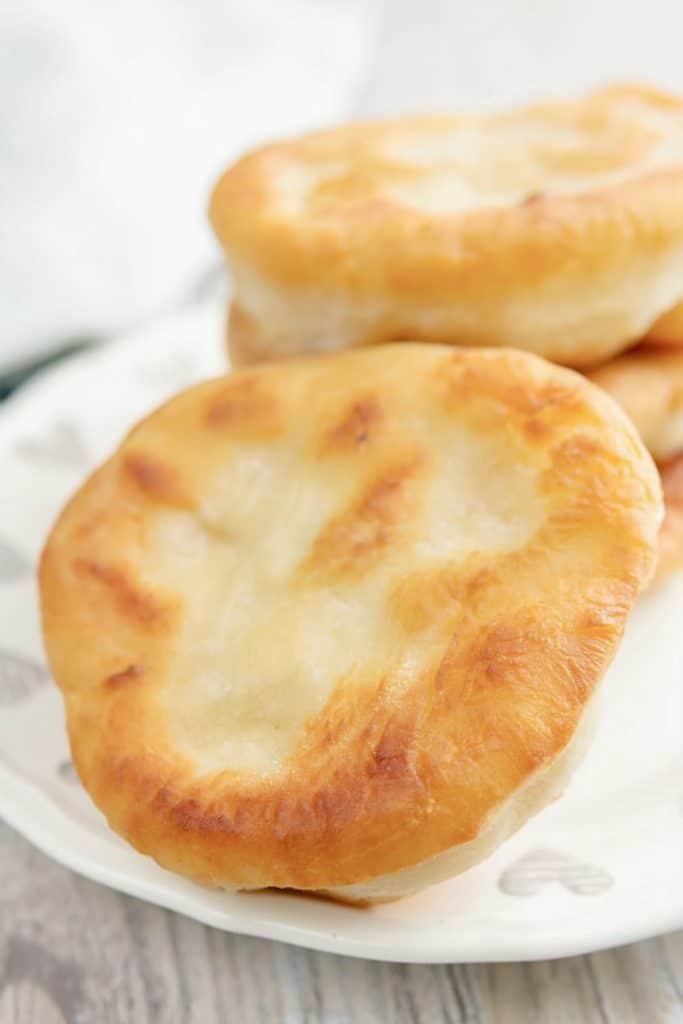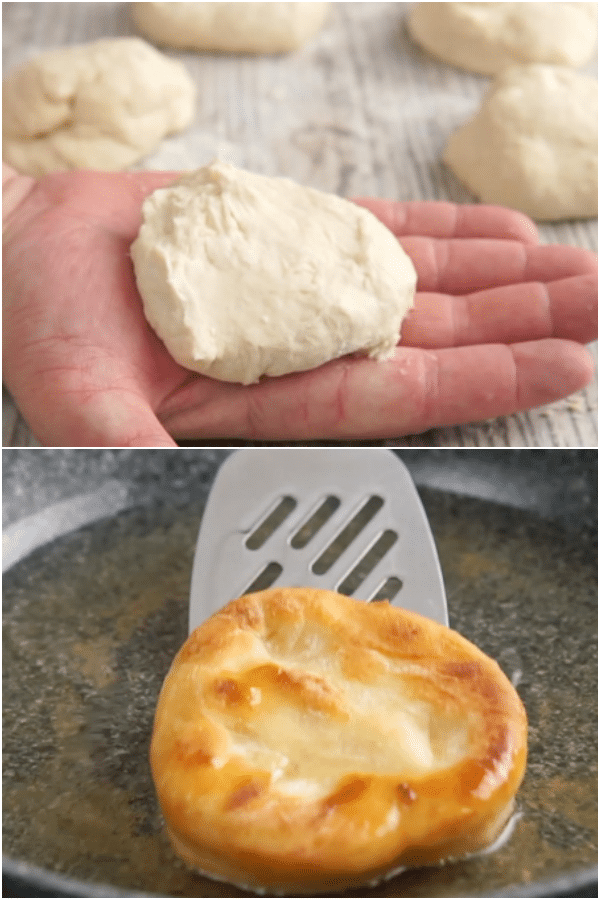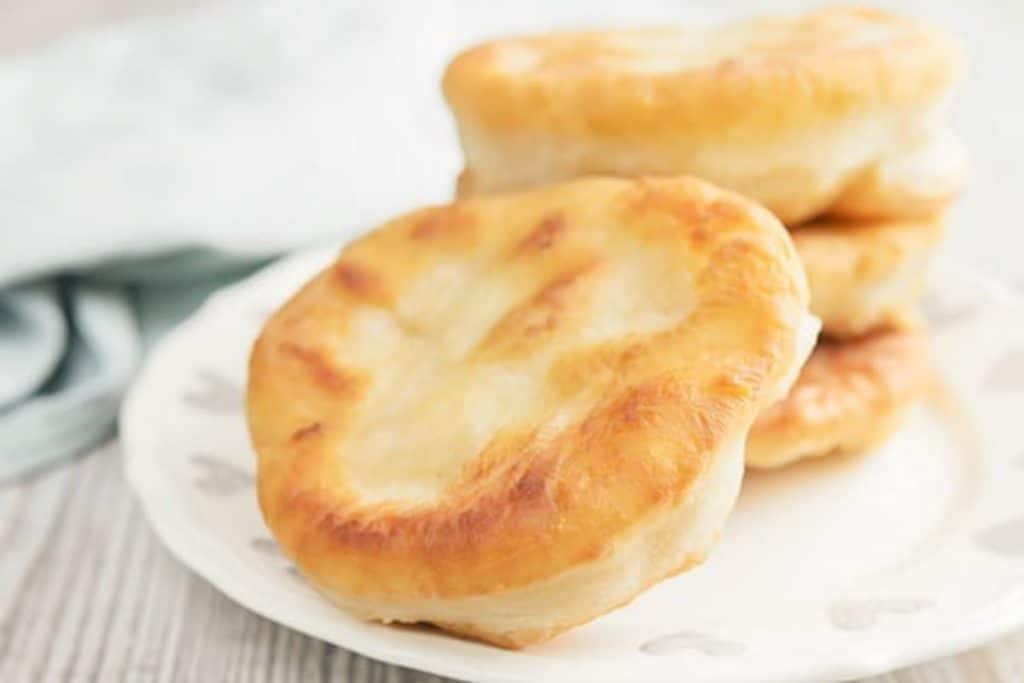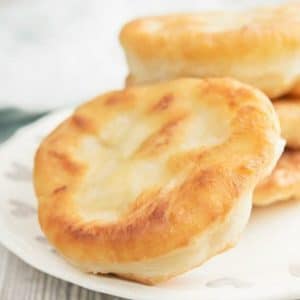Easy Bannock Bread
Bannock Bread is an easy skillet no yeast fried bread recipe. A traditional Scottish/Indigenous bread made with simple pantry ingredients. Perfect when a quick bread is required or even around the campfire!

I originally shared this recipe six years ago when Canada was celebrating 150 years.
I decided I had to include one of Canada’s Native Peoples recipes. Without getting into the political surrounding of our not so wonderful treatment of our First Nations, I would like to tell you a bit about the origin of Bannock, this simple fried bread.
Recipe Ingredients
- Flour – all purpose flour
- Baking powder
- Salt
- Oil – either olive oil or vegetable oil
- Water
- Vegetable oil for frying
As you see this type of bread has a leavening of baking powder and not yeast. Sometimes we get the urge for some bread but don’t have the time or the desire to wait for the rising time. Every now and then I like to make a No Yeast Pizza dough, or a delicious sandwich can be made with this Italian Flat Bread or why not an easy Irish Soda Bread?
How to make Bannock
In a large bowl whisk together the flour, salt and baking powder. Then add the olive oil and whisk together with a fork, gradually add water and stir until the mixture until it almost holds together.

Move to a lightly floured flat surface and gently knead about 10 times just until the dough comes together (the dough will be sticky, do not over knead).
Divide into 5 balls and flatten with the palm of your hand. In a frying pan or cast iron skillet, fry the bannock in hot oil (350F/175C)on medium heat (enough to cover the bottom of a medium frying pan), until golden brown on both sides (and cooked on the inside).
Drain on a paper towel lined plate and eat warm or at room temperature.

The Origin of Bannock Bread
Bannock an unleavened bread, was originally brought to North America by Scottish explorers and traders. Indigenous peoples in particular Métis adopted bannock in their cuisine in the eighteenth and nineteenth centuries probably after their encounters with Scottish fur traders.
As a result, even today many Métis and aboriginal western Canadians often prepare this dish. In western Canada, bannock is much more associated with native and Métis culture than with its Scottish roots.
Traditionally it was made with barley or oats, fat or lard and water. Then sugar and milk even buttermilk were added.
When to serve Bannock bread
With very few ingredients and easy to make Bannock is perfect as an accompaniment with a meal or even for Breakfast. It is often made when camping and it has been used as a staple food for wilderness explorers, trappers, and prospectors for centuries.

Tips for making the Best Bannock Bread
- Whisk the dry ingredients before adding the oil and water. I used olive oil but vegetable oil is more traditional.
- Bring the dough together with a fork.
- Move the Bannock dough to a lightly floured surface and knead only until the dough comes together.
- Do not over knead, this is not a yeast dough, and will be a little sticky, so therefore extra flour is not needed.
- Break off pieces of dough and flatten with the palm of your hand.
- Fry in hot oil on medium heat until golden brown and then turn to brown on the other side.
- Drain on paper towels.
- Eat warm or room temperature.
Can it be made with whole wheat flour?
Yes this bread can be made with whole wheat flour. It can also be baked rather than fried. Baked on a lightly oiled baking sheet in a pre-heated at 350F (180C) for 25 to 30 minutes.
Although baked Bannock is heavy and dense whereas fried is light and fluffy.
How to store Bannock
It is recommended to eat the bread as soon as it is made, this type of bread isn’t advised for storing.
I hope you decide to give this simple yeast free Bannock Bread a try and let me know what you think. Enjoy!


Easy Bannock Bread
Ingredients
- 2 cups all purpose flour
- 2 teaspoons baking powder
- ½ teaspoon salt
- 1 tablespoon olive oil or vegetable oil
- ¾ cup water
- vegetable oil for frying
Instructions
- In a large bowl whisk together the flour, salt and baking powder.
- Then add the olive oil and whisk together with a fork, gradually add water and stir until the dough almost holds together. Move to a lightly floured flat surface and gently knead about 10 times just until the dough comes together (the dough will be sticky, do not overknead).
- Divide into 5 balls and flatten with the palm of your hand. Fry in hot oil (350F/175C)on medium heat (enough to cover the bottom of a medium frying pan), until golden brown on both sides (and cooked on the inside). Drain on a paper towel lined plate and eat warm or at room temperature. Enjoy!
Notes
Nutrition
Updated from June 29, 2017.
Fantastic recipe, it produced an amazing final product and it was extremely easy! Thank you ever so much!
Hi Andrew, thanks so much, so glad you enjoyed it. Take care!
When I clicked on the metric and imperial tabs I noticed it was confusing grams with milimeters, like it says 250 grams of water (260grams) like come on, it’s 250 ml. For a cup, there are too many errors to count and it gets worse when you click on the x2 and x3 tabs I’m sorry but take a little bit of pride in your work, you have an audience, don’t squander it.
Hi Michael, I always always take pride in my work and I work darn hard doing it! I have over 1200 recipes, some of which have not been updated from over 10 years ago. I am trying to update all of them with new photos and or updates. I appreciate when readers let me know of errors so I can correct them, but I don’t appreciate when someone insinuates something that isn’t true! Take care.
Michaels mother or Father never bothered to teach him manners , example , If you don’t have something nice to say , keep it to yourself , in other words , Shut up .
Rosemary your recipe is spot on , and I love the taste of the Bannock with buttermilk , the only unfortunate part is whenever I have friends over and I make it , they are busy eating it as quickly as they are made and I get 1 or none . But thanks for the memory-its given my friends as I’m 83 and time flies when you are having friends and fun come by .
Hi Marie, thanks so much, I don’t let it get to me. Comments like yours helps too! Take care and Happy New Year.
I lived and worked in Northern Quebec fishing camps as well as the NWT…Bannock was a staple, as bread either had to be flown in (Very Expensive) or come in by sea lift in the summer when the ice was out…Nothing like warm bannock with fresh kill caribou during hunting expeditions to the mainland…We cooked it over open fires then, (The Bannock). The Caribou was better warm and raw….You can use powdered milk or even CoffeeMate in lieu of milk for bannock.
Hi Gary, thanks so much for the info! Take care.
Just a heads up to people, as an indigenous person I feel the need to tell you that your oil may be too hot if the inside isn’t cooking but the outside is. Get as low as you can while still being able to fry. Hope this helps
Yum! Thank you.
Hi TH, thanks glad you like it. Take care!
Bannock bread was never been a traditional indigenous recipe. It’s a Scottish recipe that was shared with the indigenous people.
The “modern” bannock made with flour is originally a Scottish recipe but Indigenous people made bannock for generations using the camas plant. But yes, as I understand it, they adopted the flour version once it was introduced by Europeans.
It didn’t cook properly. Found it a bit raw
Hi Anna, make sure you cook it in the pan longer. Take care!